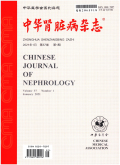甲状旁腺素通过Wnt/β-catenin信号通路诱导内皮细胞发生内皮-脂肪细胞转分化
Parathyroid hormone induces endothelial - to - adipocyte transition in endothelial cells by Wnt/β-catenin pathway
摘要目的观察甲状旁腺素(PTH)是否可诱导内皮细胞内皮-间充质转分化(EndMT)及进一步转化为脂肪细胞,并对其可能机制进行探讨.方法(1)动物实验:构建慢性肾脏病(CKD)合并甲状旁腺功能亢进大鼠模型.油红O脂肪染色检测大鼠骨髓脂肪组织含量,免疫荧光双染检测骨髓内皮细胞分化抗原31(CD31)和成纤维细胞特异性蛋白1(FSP1)的表达情况.(2)细胞实验:体外培养人脐静脉内皮细胞,使用Western印迹检测不同浓度(0、10-11、10-9、10-7 mol/L,48 h)及时间(0、12、24、48 h,10-7 mol/L PTH)PTH干预下EndMT标志物CD31、FSP1和α平滑肌肌动蛋白(α-SMA)蛋白表达变化及不同浓度PTH干预下核转录因子β连环蛋白(β-catenin)表达变化,免疫荧光观察CD31、FSP1和β-catenin的表达及定位.PTH干预后脂肪细胞培养基进一步诱导分化1周,Western印迹和油红O脂肪染色分别检测脂肪细胞标志物过氧化物酶体增殖物活化受体γ(PPAR-γ)、CCAAT增强子结合蛋白-α(C/EBP-α)的表达和细胞脂肪量.使用siRNA阻断β-catenin信号通路,分为对照siRNA组、β-catenin siRNA组、PTH+对照siRNA组和PTH+β-catenin siRNA组.Western印迹检测各组内皮细胞CD31、FSP1的蛋白表达及进一步诱导成脂后PPAR-γ的表达,油红O脂肪染色检测脂肪量.结果(1)CKD大鼠骨髓脂肪细胞多于对照组(P<0.05),骨髓内皮细胞存在CD31和FSP1共表达.(2)PTH干扰降低内皮细胞CD31的蛋白表达,增加FSP1和α-SMA表达,且呈浓度和时间依赖性.10-7 mol/L PTH组和48 h组以上指标分别与0 mol/L PTH组和0 h组比较差异均有统计学意义(均P<0.05).10-7 mol/L PTH干预48 h细胞质大量表达FSP1,并伴随CD31表达减少.进一步诱导分化成脂,PTH组PPAR-γ和C/EBP-α蛋白表达、脂肪量均高于对照组(均P<0.05).PTH干扰增加核转录β-catenin表达且呈浓度依赖性.10-7 mol/L PTH组β-catenin蛋白表达与0 mol/L PTH组比较差异有统计学意义(P<0.05).对照组β-catenin主要在细胞膜上表达,PTH组β-catenin大量进入细胞核中.与PTH+对照siRNA组比较,PTH+β-catenin siRNA组CD31、PPAR-γ蛋白表达和脂肪量均减少,FSP1蛋白表达增加(均P<0.05).结论PTH可诱导内皮细胞通过EndMT发生内皮-脂肪细胞转分化,从而参与CKD骨质疏松的发生.其作用与经典Wnt/β-catenin信号通路有关,阻断β-catenin能减轻PTH诱导的EndMT和脂肪细胞形成.
更多相关知识
abstractsObjective To investigate whether elevated parathyroid hormone (PTH) levels could induce endothelial - to - mesenchymal transition (EndMT) and adipocyte transition in endothelial cells (ECs), and to determine the possible underlying mechanism. Methods (1) A rat model of secondary hyperparathyroidism and chronic kidney disease (CKD) was established. The adiposity in bone marrow was detected by oil red O staining. Immunofluorescence staining was performed to detect the expression and localization of cluster of differentiation 31 (CD31) and fibroblast-specific protein 1 (FSP1). (2) The human umbilical vein ECs were cultured in vitro. Western blotting was performed to detect protein expressions of EndMT-related markers CD31, FSP1 and α-smooth muscle actin (α-SMA) in interference groups with different PTH concentrations (0, 10-11, 10-9, 10-7 mol/L PTH for 48 h) and times (0, 12, 24, 48 h, 10-7 mol/L PTH), as well as the expression of β-catenin in interference groups with different PTH concentrations. The localizations of CD31, FSP1 and β - catenin were observed by cell immunofluorescence. Protein expressions of adipocytes markers peroxisome proliferator - activated receptor-γ (PPAR-γ) and CCAAT/enhancer binding protein-α (C/EBP-α) by Western blotting and the degree of adipogenesis by oil red O staining were detected after transformed ECs were cultured in adipogenic culture medium for one week. Small interfering RNA (siRNA) was performed to silenceβ - catenin expression. ECs were divided into control siRNA group, β - catenin siRNA group, PTH +control siRNA group and PTH+β-catenin siRNA group. Protein expressions of CD31, FSP1 and PPAR-γby Western blotting and the degree of adipogenesis by oil red O staining were determined. Results (1) In vivo, compared with the control, CKD rats had increased adipocytes in bone marrow (P<0.05), and the co-expression of CD31 and FSP1 in bone marrow ECs. (2) In vitro, PTH significantly inhibited the expression of endothelial marker CD31 and increased the expressions of mesenchymal markers FSP1 and α-SMA in concentration-and time-dependent manners. These indexes in 10-7 mol/L PTH group and 0 mol/L PTH group, in 48 h group and 0 h group showed statistical differences (all P<0.05). In PTH group ECs with 10-7 mol/L PTH for 48 h showed FSP1 accumulation in the cytoplasm and reduced expressions of CD31, and ECs had higher expressions of PPAR-γ and C/EBP-α as well as the degree of adipogenesis than those in control group (all P<0.05). Furthermore, PTH enhanced the nuclearβ-catenin protein levels in ECs in concentration-dependent. The expressions of β-catenin in 10-7 mol/L PTH group and 0 mol/L PTH group showed statistical differences (P<0.05). β - catenin expressed in the cytoplasm in control group, while it enter into the nucleus in PTH group. Compared with those in PTH+control siRNA group, the expressions of CD31 and PPAR-γ as well as the degree of adipogenesis decreased in PTH+β-catenin siRNA group (all P<0.05), while the expression of FSP1 increased (P<0.05). Conclusions PTH induces ECs - to - adipocytes transition by the canonical Wnt/β - catenin signaling pathway, which might account for bone loss in CKD. Silenced β - catenin expression can inhibit PTH-induced EndMT and adipogenesis.
More相关知识
- 浏览227
- 被引5
- 下载224


相似文献
- 中文期刊
- 外文期刊
- 学位论文
- 会议论文



 换一批
换一批 换一批
换一批



